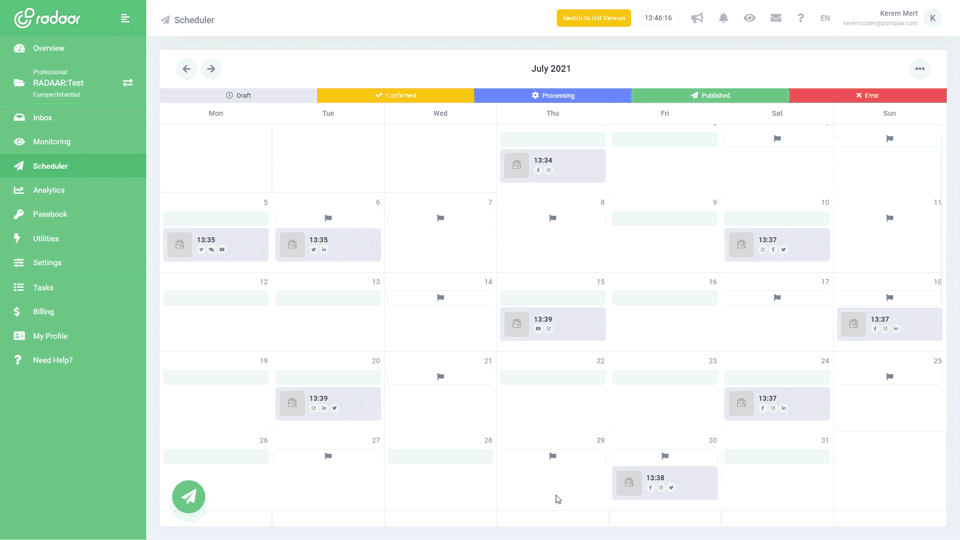Are you ready to master newsletter planning that converts?
Discover the secrets behind crafting compelling newsletters that truly engage and convert your audience. Dive into our guide on mastering newsletter planning for maximum impact and results!
LEARN MORE LAUNCH DEMO NOW Are you ready to elevate your newsletter game to new heights? Imagine crafting compelling newsletters that not only captivate your audience but also drive meaningful conversions. Whether you're a seasoned marketer or just starting out, mastering newsletter planning is a crucial step to boost your marketing strategy. In this blog post, we're diving deep into the tactics and strategies that will help you create newsletters that not only look great but also deliver powerful results.
The effectiveness of a well-planned newsletter can't be overstated—it’s your direct line to connect with your audience and foster a sense of community. From understanding your target audience to crafting irresistible subject lines and compelling content, we’ll cover every essential element. Let's embark on this journey to transform your newsletters from mundane to magnetic, ensuring every email you send is eagerly anticipated and drives action. Ready to become a newsletter planning maestro? Let's get started!
The effectiveness of a well-planned newsletter can't be overstated—it’s your direct line to connect with your audience and foster a sense of community. From understanding your target audience to crafting irresistible subject lines and compelling content, we’ll cover every essential element. Let's embark on this journey to transform your newsletters from mundane to magnetic, ensuring every email you send is eagerly anticipated and drives action. Ready to become a newsletter planning maestro? Let's get started!
Table of Contents
- How do you identify your target audience?
- What content resonates with your audience most?
- How to create a content calendar that converts?
- Why is personalization key in newsletter success?
- How do you craft compelling subject lines?
- What role does design play in newsletters?
- How do you measure the success of newsletters?
- How can feedback improve your newsletter strategy?
- Are you ready to take your newsletters to the next level?
How do you identify your target audience?
Identifying your target audience starts with understanding who would benefit most from your content. Begin by analyzing your current subscribers or customers and take note of their demographics, interests, and online behavior. Use surveys, social media insights, and website analytics to gather more detailed information. This comprehensive approach will help you create a personalized and engaging newsletter that resonates specifically with your intended audience, ensuring higher conversion rates.
What content resonates with your audience most?
Understanding what content resonates most with your audience is the cornerstone of a successful newsletter strategy. Put yourself in their shoes and consider what challenges they face, what interests them, and what actionable insights they crave. Offer a mix of tips, heartfelt stories, and exclusive updates to keep them engaged and eager for more. By consistently delivering value that's aligned with their needs and desires, you'll cultivate a loyal readership that not only opens your emails but takes action.
How to create a content calendar that converts?
Creating a content calendar that converts is all about strategic planning and consistency. Start by identifying your audience's needs and interests, then map out a month-by-month plan that includes engaging topics, optimal posting times, and clear call-to-actions. Don’t forget to mix up your content types – blend informative articles, case studies, and engaging visuals to keep your subscribers hooked. By meticulously scheduling and sticking to a well-thought-out plan, you’ll build anticipation and trust, leading to higher conversion rates.
Why is personalization key in newsletter success?
Personalization is key in newsletter success because it makes readers feel valued and understood, increasing their engagement and loyalty. When you tailor content to individual preferences and behaviors, subscribers are more likely to open, read, and act on your messages. It also helps to build a stronger connection with your audience, fostering trust and long-term relationships. Ultimately, personalization can significantly boost your conversion rates, turning casual readers into dedicated customers.
How do you craft compelling subject lines?
Crafting compelling subject lines is both an art and a science, and finding that perfect balance can significantly boost your open rates. Start by understanding your audience; knowing what grabs their attention is key. Use action-oriented language and strong verbs that prompt readers to engage immediately. Words like "discover," "upgrade," "unlock," and "exclusive" can create a sense of urgency and curiosity.
Personalization is another powerful tool—incorporating the recipient's name or mentioning a recent interaction can make your email feel tailor-made. Keeping your subject lines concise and clear is also critical; a good rule of thumb is to keep it under 50 characters to ensure it displays well on all devices. Finally, don't be afraid to use emojis sparingly to add a human touch and make your subject line stand out in a crowded inbox.
Personalization is another powerful tool—incorporating the recipient's name or mentioning a recent interaction can make your email feel tailor-made. Keeping your subject lines concise and clear is also critical; a good rule of thumb is to keep it under 50 characters to ensure it displays well on all devices. Finally, don't be afraid to use emojis sparingly to add a human touch and make your subject line stand out in a crowded inbox.
What role does design play in newsletters?
Design plays a pivotal role in newsletters by making them visually appealing and easy to navigate. A well-designed newsletter captures the reader's attention, encourages engagement, and enhances the overall user experience. Effective use of colors, fonts, and images can highlight key messages and make the content more memorable. Ultimately, a clean and aesthetically pleasing design helps improve readability and increases the chances of conversion.
How do you measure the success of newsletters?
Measuring the success of your newsletters hinges on several key metrics, each offering valuable insights into different aspects of engagement and performance. One of the primary metrics to focus on is the **open rate**, which indicates how many recipients actually opened your email. A higher open rate suggests that your subject line was compelling and your timing was on point. Additionally, the **click-through rate (CTR)** is crucial, as it reflects how many recipients not only opened your email but also clicked on links within it, signifying deeper engagement with your content.
Another essential metric is the **conversion rate**, which tracks the percentage of recipients who took a desired action, such as making a purchase or signing up for an event, after clicking through your newsletter. This metric directly correlates with the ultimate goal of your campaign—whether to drive sales, increase registrations, or achieve some other objective. Don't forget to pay attention to the **unsubscribe rate**; a rising number of unsubscribes can indicate that your content isn't resonating with your audience or that you’re sending emails too frequently. Monitoring these metrics continuously will help you fine-tune your newsletter strategy for better results and higher conversions.
Another essential metric is the **conversion rate**, which tracks the percentage of recipients who took a desired action, such as making a purchase or signing up for an event, after clicking through your newsletter. This metric directly correlates with the ultimate goal of your campaign—whether to drive sales, increase registrations, or achieve some other objective. Don't forget to pay attention to the **unsubscribe rate**; a rising number of unsubscribes can indicate that your content isn't resonating with your audience or that you’re sending emails too frequently. Monitoring these metrics continuously will help you fine-tune your newsletter strategy for better results and higher conversions.
How can feedback improve your newsletter strategy?
Feedback can be a game-changer in refining your newsletter strategy to boost conversions. By actively listening to your audience's needs and preferences, you can tailor your content to resonate more deeply with them. This not only enhances engagement but also builds trust, making subscribers more likely to take action. Incorporating constructive criticism and positive suggestions ensures your newsletter remains relevant, valuable, and compelling.
Are you ready to take your newsletters to the next level?
So, are you ready to take your newsletters to the next level? With strategic planning, compelling content, and targeted insights, your newsletters can transform from mundane updates to powerful marketing tools that engage and convert. Embrace the art of storytelling, leverage the power of personalization, and always prioritize value over volume. Remember, the secret lies in understanding your audience's needs and providing them with solutions and insights that resonate.
If you consistently implement these strategies, you'll not only see an improvement in your open and click-through rates but also foster a greater sense of loyalty and trust with your readers. Your newsletters will become a go-to resource, driving engagement and boosting conversions. So, don't wait any longer—start refining your newsletter planning today and watch your efforts pay off in meaningful and measurable ways. Happy planning, and here's to your newsletter success!
If you consistently implement these strategies, you'll not only see an improvement in your open and click-through rates but also foster a greater sense of loyalty and trust with your readers. Your newsletters will become a go-to resource, driving engagement and boosting conversions. So, don't wait any longer—start refining your newsletter planning today and watch your efforts pay off in meaningful and measurable ways. Happy planning, and here's to your newsletter success!
SOCIAL MEDIA SCHEDULER
Plan and publish...
Plan and publish your content for Facebook, Instagram, Twitter, and LinkedIn from one simple dashboard.
LEARN MORE FREQUENTLY ASKED QUESTIONS
What is social media management platform?
RELATED BLOG POSTS
All the tips & tricks you'll need...
Get the fresh tips and tricks you'll need to ace social media marketing.












